Work Stress and Its Adverse Effects on Employees: A Report
VerifiedAdded on 2022/11/10
|21
|4661
|205
Report
AI Summary
This report delves into the critical issue of work stress and its detrimental effects on employees, focusing on a case study of a telecommunications corporation. The analysis begins by defining work stress and exploring its various sources, including increased workloads, aggressive targets, and the impact of restructuring. The report examines how work stress negatively impacts employee job satisfaction, engagement, and retention. It highlights the direct correlation between high stress levels and reduced job satisfaction, decreased engagement, and an increased likelihood of employee attrition. The report then suggests evidence-based interventions to mitigate work stress, such as improved management practices, workload balancing, and employee support programs, while also critiquing their strengths and weaknesses. The study underscores the importance of addressing work stress to maintain employee well-being, enhance productivity, and ensure the long-term success of the organization. The report emphasizes the need for proactive measures to create a healthier work environment and improve employee retention rates.
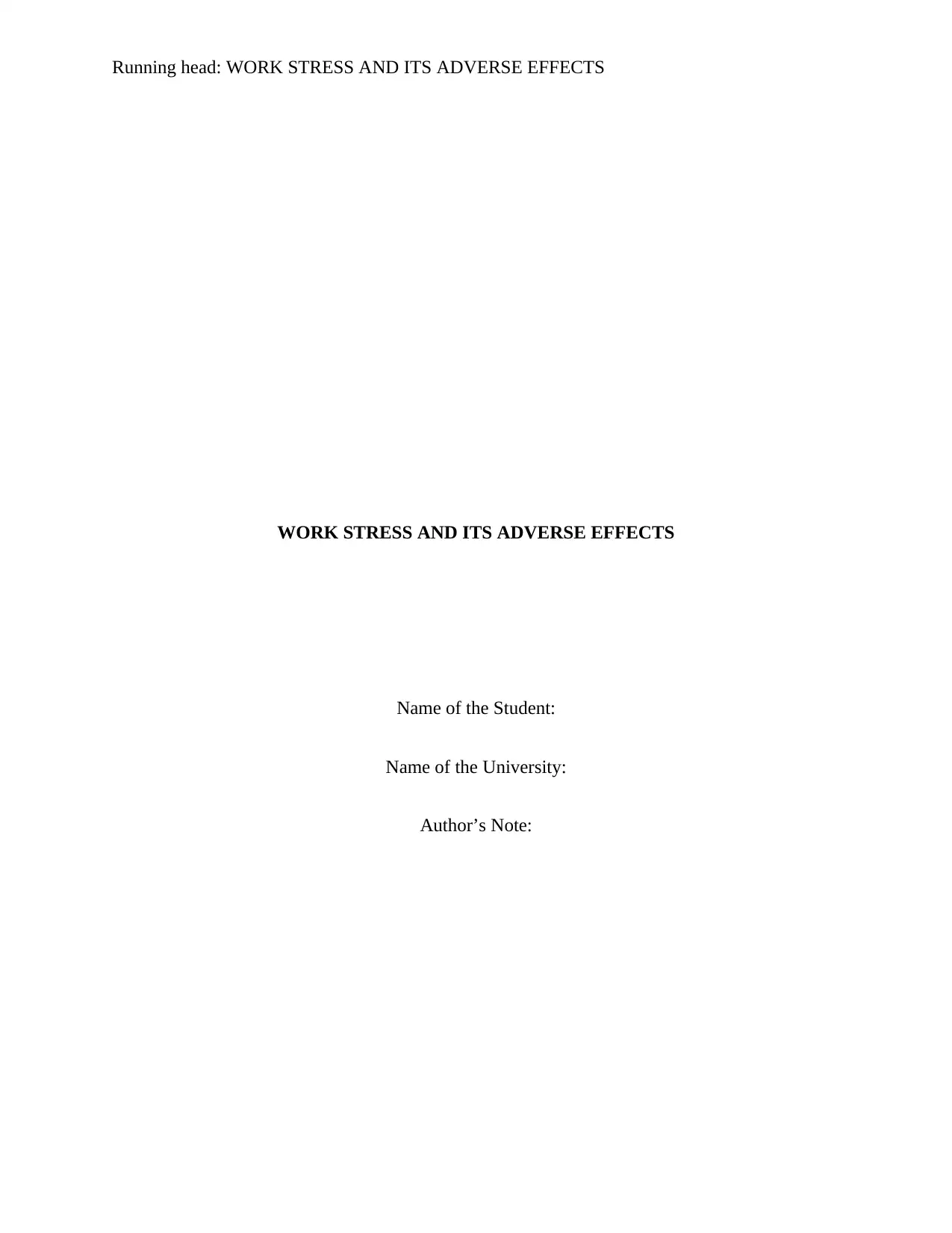
Running head: WORK STRESS AND ITS ADVERSE EFFECTS
WORK STRESS AND ITS ADVERSE EFFECTS
Name of the Student:
Name of the University:
Author’s Note:
WORK STRESS AND ITS ADVERSE EFFECTS
Name of the Student:
Name of the University:
Author’s Note:
Paraphrase This Document
Need a fresh take? Get an instant paraphrase of this document with our AI Paraphraser
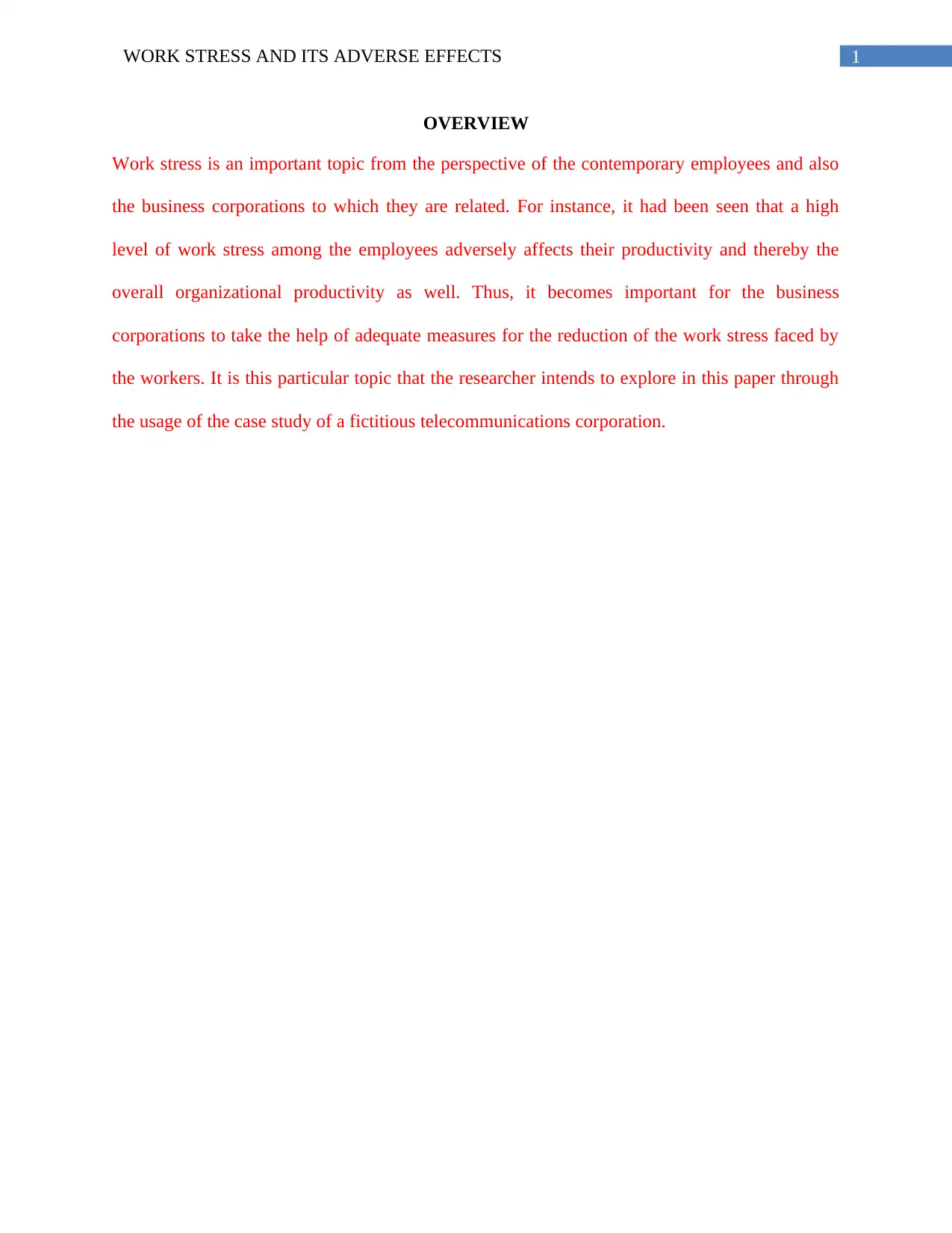
1WORK STRESS AND ITS ADVERSE EFFECTS
OVERVIEW
Work stress is an important topic from the perspective of the contemporary employees and also
the business corporations to which they are related. For instance, it had been seen that a high
level of work stress among the employees adversely affects their productivity and thereby the
overall organizational productivity as well. Thus, it becomes important for the business
corporations to take the help of adequate measures for the reduction of the work stress faced by
the workers. It is this particular topic that the researcher intends to explore in this paper through
the usage of the case study of a fictitious telecommunications corporation.
OVERVIEW
Work stress is an important topic from the perspective of the contemporary employees and also
the business corporations to which they are related. For instance, it had been seen that a high
level of work stress among the employees adversely affects their productivity and thereby the
overall organizational productivity as well. Thus, it becomes important for the business
corporations to take the help of adequate measures for the reduction of the work stress faced by
the workers. It is this particular topic that the researcher intends to explore in this paper through
the usage of the case study of a fictitious telecommunications corporation.
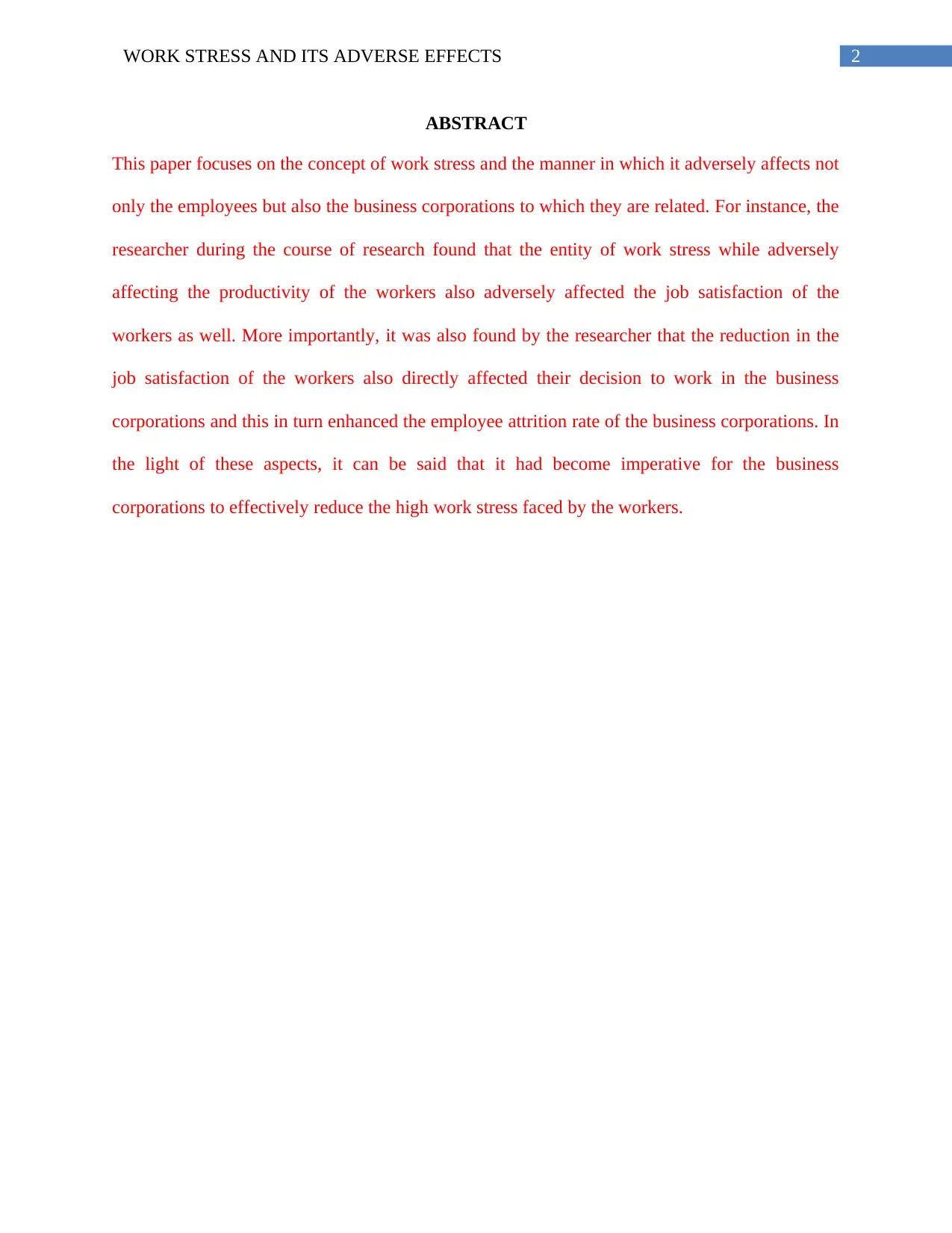
2WORK STRESS AND ITS ADVERSE EFFECTS
ABSTRACT
This paper focuses on the concept of work stress and the manner in which it adversely affects not
only the employees but also the business corporations to which they are related. For instance, the
researcher during the course of research found that the entity of work stress while adversely
affecting the productivity of the workers also adversely affected the job satisfaction of the
workers as well. More importantly, it was also found by the researcher that the reduction in the
job satisfaction of the workers also directly affected their decision to work in the business
corporations and this in turn enhanced the employee attrition rate of the business corporations. In
the light of these aspects, it can be said that it had become imperative for the business
corporations to effectively reduce the high work stress faced by the workers.
ABSTRACT
This paper focuses on the concept of work stress and the manner in which it adversely affects not
only the employees but also the business corporations to which they are related. For instance, the
researcher during the course of research found that the entity of work stress while adversely
affecting the productivity of the workers also adversely affected the job satisfaction of the
workers as well. More importantly, it was also found by the researcher that the reduction in the
job satisfaction of the workers also directly affected their decision to work in the business
corporations and this in turn enhanced the employee attrition rate of the business corporations. In
the light of these aspects, it can be said that it had become imperative for the business
corporations to effectively reduce the high work stress faced by the workers.
⊘ This is a preview!⊘
Do you want full access?
Subscribe today to unlock all pages.

Trusted by 1+ million students worldwide
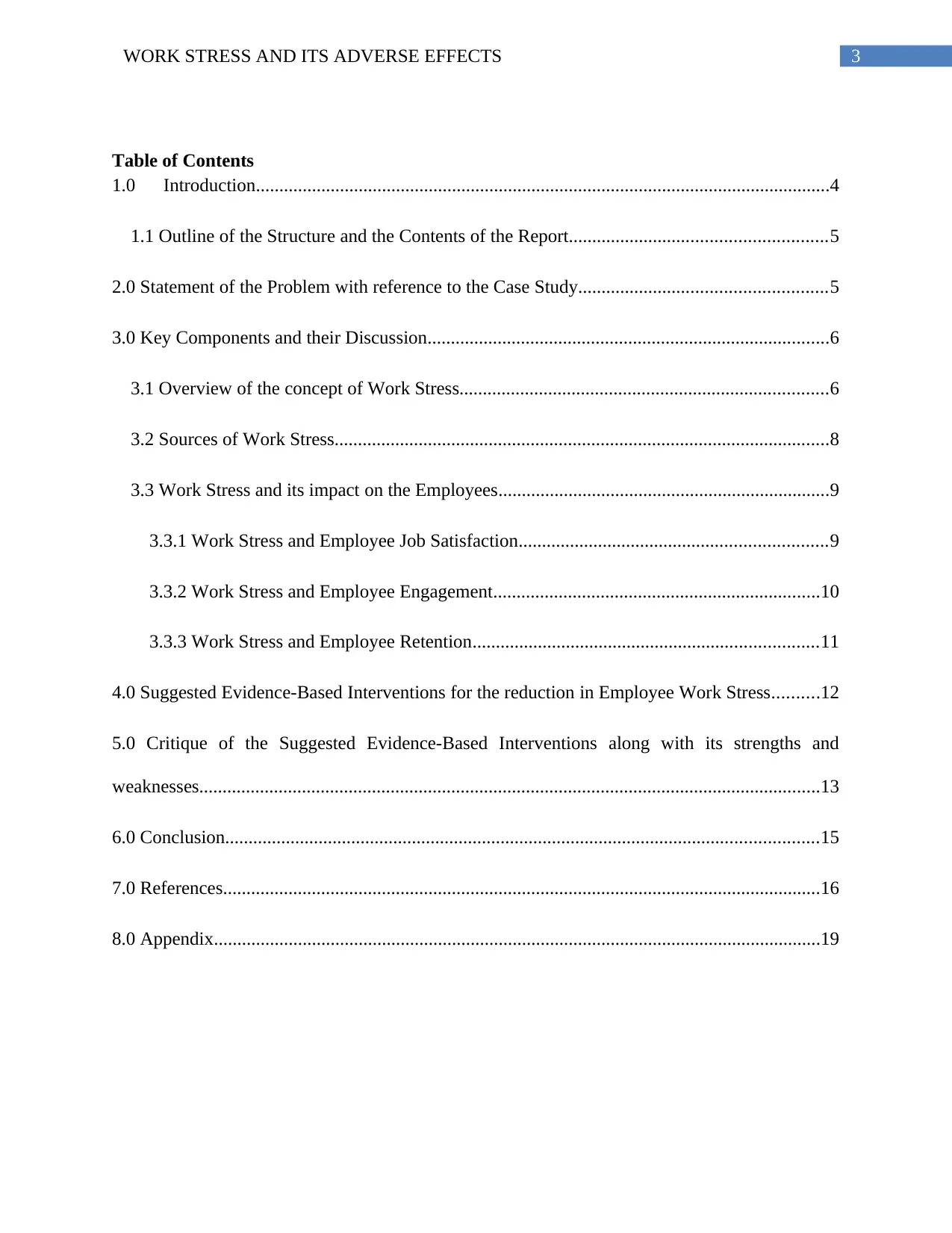
3WORK STRESS AND ITS ADVERSE EFFECTS
Table of Contents
1.0 Introduction...........................................................................................................................4
1.1 Outline of the Structure and the Contents of the Report.......................................................5
2.0 Statement of the Problem with reference to the Case Study.....................................................5
3.0 Key Components and their Discussion......................................................................................6
3.1 Overview of the concept of Work Stress...............................................................................6
3.2 Sources of Work Stress..........................................................................................................8
3.3 Work Stress and its impact on the Employees.......................................................................9
3.3.1 Work Stress and Employee Job Satisfaction..................................................................9
3.3.2 Work Stress and Employee Engagement......................................................................10
3.3.3 Work Stress and Employee Retention..........................................................................11
4.0 Suggested Evidence-Based Interventions for the reduction in Employee Work Stress..........12
5.0 Critique of the Suggested Evidence-Based Interventions along with its strengths and
weaknesses.....................................................................................................................................13
6.0 Conclusion...............................................................................................................................15
7.0 References................................................................................................................................16
8.0 Appendix..................................................................................................................................19
Table of Contents
1.0 Introduction...........................................................................................................................4
1.1 Outline of the Structure and the Contents of the Report.......................................................5
2.0 Statement of the Problem with reference to the Case Study.....................................................5
3.0 Key Components and their Discussion......................................................................................6
3.1 Overview of the concept of Work Stress...............................................................................6
3.2 Sources of Work Stress..........................................................................................................8
3.3 Work Stress and its impact on the Employees.......................................................................9
3.3.1 Work Stress and Employee Job Satisfaction..................................................................9
3.3.2 Work Stress and Employee Engagement......................................................................10
3.3.3 Work Stress and Employee Retention..........................................................................11
4.0 Suggested Evidence-Based Interventions for the reduction in Employee Work Stress..........12
5.0 Critique of the Suggested Evidence-Based Interventions along with its strengths and
weaknesses.....................................................................................................................................13
6.0 Conclusion...............................................................................................................................15
7.0 References................................................................................................................................16
8.0 Appendix..................................................................................................................................19
Paraphrase This Document
Need a fresh take? Get an instant paraphrase of this document with our AI Paraphraser
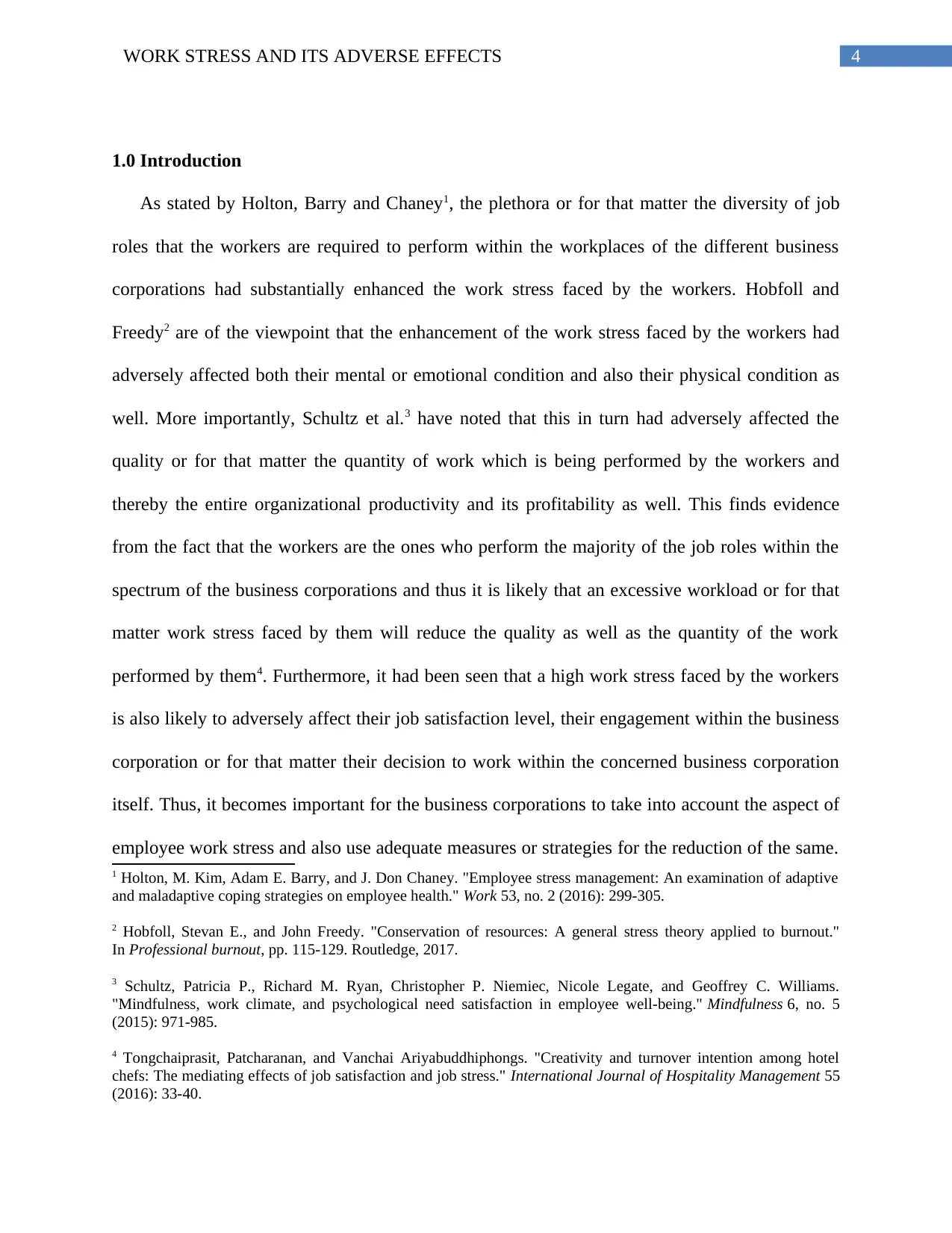
4WORK STRESS AND ITS ADVERSE EFFECTS
1.0 Introduction
As stated by Holton, Barry and Chaney1, the plethora or for that matter the diversity of job
roles that the workers are required to perform within the workplaces of the different business
corporations had substantially enhanced the work stress faced by the workers. Hobfoll and
Freedy2 are of the viewpoint that the enhancement of the work stress faced by the workers had
adversely affected both their mental or emotional condition and also their physical condition as
well. More importantly, Schultz et al.3 have noted that this in turn had adversely affected the
quality or for that matter the quantity of work which is being performed by the workers and
thereby the entire organizational productivity and its profitability as well. This finds evidence
from the fact that the workers are the ones who perform the majority of the job roles within the
spectrum of the business corporations and thus it is likely that an excessive workload or for that
matter work stress faced by them will reduce the quality as well as the quantity of the work
performed by them4. Furthermore, it had been seen that a high work stress faced by the workers
is also likely to adversely affect their job satisfaction level, their engagement within the business
corporation or for that matter their decision to work within the concerned business corporation
itself. Thus, it becomes important for the business corporations to take into account the aspect of
employee work stress and also use adequate measures or strategies for the reduction of the same.
1 Holton, M. Kim, Adam E. Barry, and J. Don Chaney. "Employee stress management: An examination of adaptive
and maladaptive coping strategies on employee health." Work 53, no. 2 (2016): 299-305.
2 Hobfoll, Stevan E., and John Freedy. "Conservation of resources: A general stress theory applied to burnout."
In Professional burnout, pp. 115-129. Routledge, 2017.
3 Schultz, Patricia P., Richard M. Ryan, Christopher P. Niemiec, Nicole Legate, and Geoffrey C. Williams.
"Mindfulness, work climate, and psychological need satisfaction in employee well-being." Mindfulness 6, no. 5
(2015): 971-985.
4 Tongchaiprasit, Patcharanan, and Vanchai Ariyabuddhiphongs. "Creativity and turnover intention among hotel
chefs: The mediating effects of job satisfaction and job stress." International Journal of Hospitality Management 55
(2016): 33-40.
1.0 Introduction
As stated by Holton, Barry and Chaney1, the plethora or for that matter the diversity of job
roles that the workers are required to perform within the workplaces of the different business
corporations had substantially enhanced the work stress faced by the workers. Hobfoll and
Freedy2 are of the viewpoint that the enhancement of the work stress faced by the workers had
adversely affected both their mental or emotional condition and also their physical condition as
well. More importantly, Schultz et al.3 have noted that this in turn had adversely affected the
quality or for that matter the quantity of work which is being performed by the workers and
thereby the entire organizational productivity and its profitability as well. This finds evidence
from the fact that the workers are the ones who perform the majority of the job roles within the
spectrum of the business corporations and thus it is likely that an excessive workload or for that
matter work stress faced by them will reduce the quality as well as the quantity of the work
performed by them4. Furthermore, it had been seen that a high work stress faced by the workers
is also likely to adversely affect their job satisfaction level, their engagement within the business
corporation or for that matter their decision to work within the concerned business corporation
itself. Thus, it becomes important for the business corporations to take into account the aspect of
employee work stress and also use adequate measures or strategies for the reduction of the same.
1 Holton, M. Kim, Adam E. Barry, and J. Don Chaney. "Employee stress management: An examination of adaptive
and maladaptive coping strategies on employee health." Work 53, no. 2 (2016): 299-305.
2 Hobfoll, Stevan E., and John Freedy. "Conservation of resources: A general stress theory applied to burnout."
In Professional burnout, pp. 115-129. Routledge, 2017.
3 Schultz, Patricia P., Richard M. Ryan, Christopher P. Niemiec, Nicole Legate, and Geoffrey C. Williams.
"Mindfulness, work climate, and psychological need satisfaction in employee well-being." Mindfulness 6, no. 5
(2015): 971-985.
4 Tongchaiprasit, Patcharanan, and Vanchai Ariyabuddhiphongs. "Creativity and turnover intention among hotel
chefs: The mediating effects of job satisfaction and job stress." International Journal of Hospitality Management 55
(2016): 33-40.
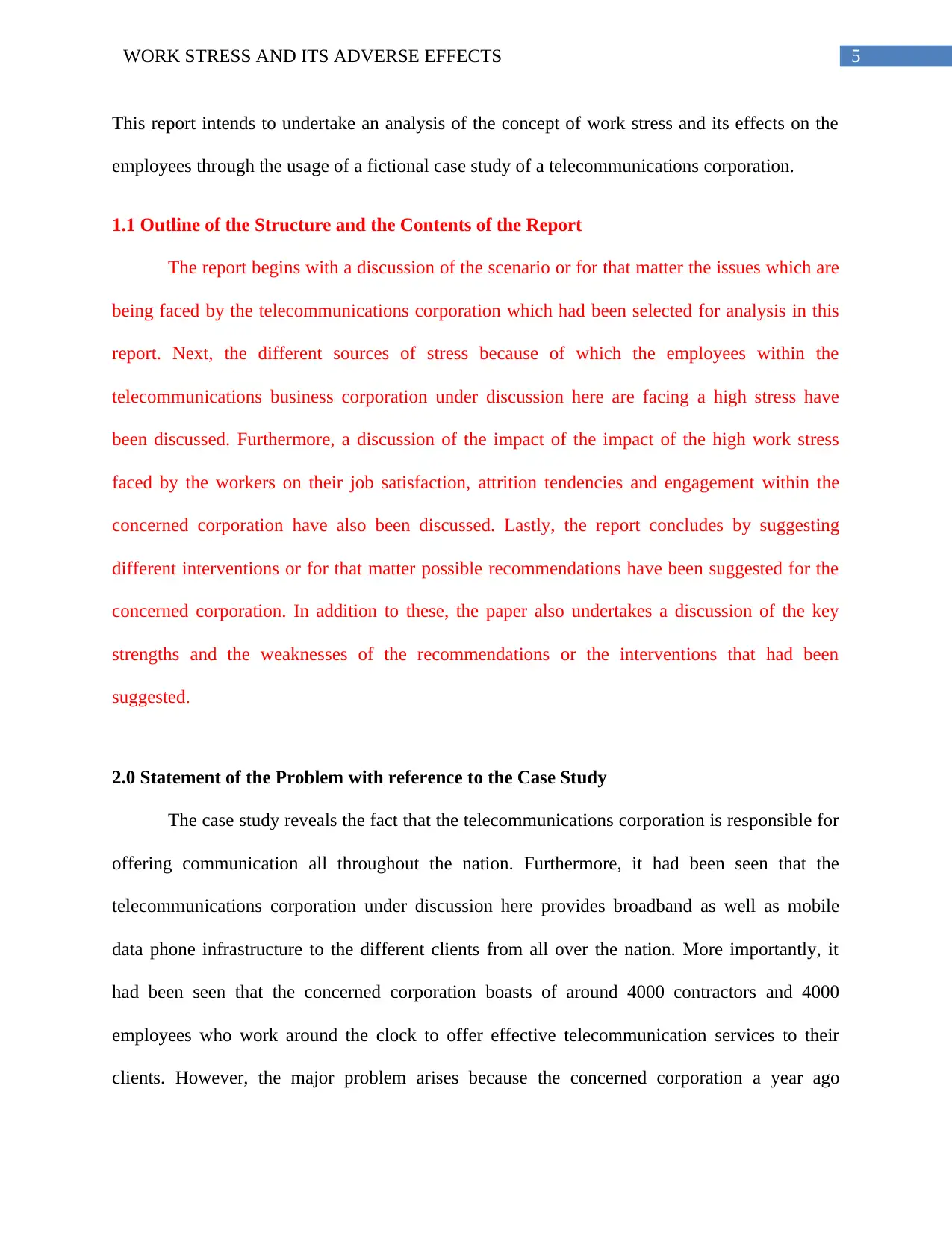
5WORK STRESS AND ITS ADVERSE EFFECTS
This report intends to undertake an analysis of the concept of work stress and its effects on the
employees through the usage of a fictional case study of a telecommunications corporation.
1.1 Outline of the Structure and the Contents of the Report
The report begins with a discussion of the scenario or for that matter the issues which are
being faced by the telecommunications corporation which had been selected for analysis in this
report. Next, the different sources of stress because of which the employees within the
telecommunications business corporation under discussion here are facing a high stress have
been discussed. Furthermore, a discussion of the impact of the impact of the high work stress
faced by the workers on their job satisfaction, attrition tendencies and engagement within the
concerned corporation have also been discussed. Lastly, the report concludes by suggesting
different interventions or for that matter possible recommendations have been suggested for the
concerned corporation. In addition to these, the paper also undertakes a discussion of the key
strengths and the weaknesses of the recommendations or the interventions that had been
suggested.
2.0 Statement of the Problem with reference to the Case Study
The case study reveals the fact that the telecommunications corporation is responsible for
offering communication all throughout the nation. Furthermore, it had been seen that the
telecommunications corporation under discussion here provides broadband as well as mobile
data phone infrastructure to the different clients from all over the nation. More importantly, it
had been seen that the concerned corporation boasts of around 4000 contractors and 4000
employees who work around the clock to offer effective telecommunication services to their
clients. However, the major problem arises because the concerned corporation a year ago
This report intends to undertake an analysis of the concept of work stress and its effects on the
employees through the usage of a fictional case study of a telecommunications corporation.
1.1 Outline of the Structure and the Contents of the Report
The report begins with a discussion of the scenario or for that matter the issues which are
being faced by the telecommunications corporation which had been selected for analysis in this
report. Next, the different sources of stress because of which the employees within the
telecommunications business corporation under discussion here are facing a high stress have
been discussed. Furthermore, a discussion of the impact of the impact of the high work stress
faced by the workers on their job satisfaction, attrition tendencies and engagement within the
concerned corporation have also been discussed. Lastly, the report concludes by suggesting
different interventions or for that matter possible recommendations have been suggested for the
concerned corporation. In addition to these, the paper also undertakes a discussion of the key
strengths and the weaknesses of the recommendations or the interventions that had been
suggested.
2.0 Statement of the Problem with reference to the Case Study
The case study reveals the fact that the telecommunications corporation is responsible for
offering communication all throughout the nation. Furthermore, it had been seen that the
telecommunications corporation under discussion here provides broadband as well as mobile
data phone infrastructure to the different clients from all over the nation. More importantly, it
had been seen that the concerned corporation boasts of around 4000 contractors and 4000
employees who work around the clock to offer effective telecommunication services to their
clients. However, the major problem arises because the concerned corporation a year ago
⊘ This is a preview!⊘
Do you want full access?
Subscribe today to unlock all pages.

Trusted by 1+ million students worldwide
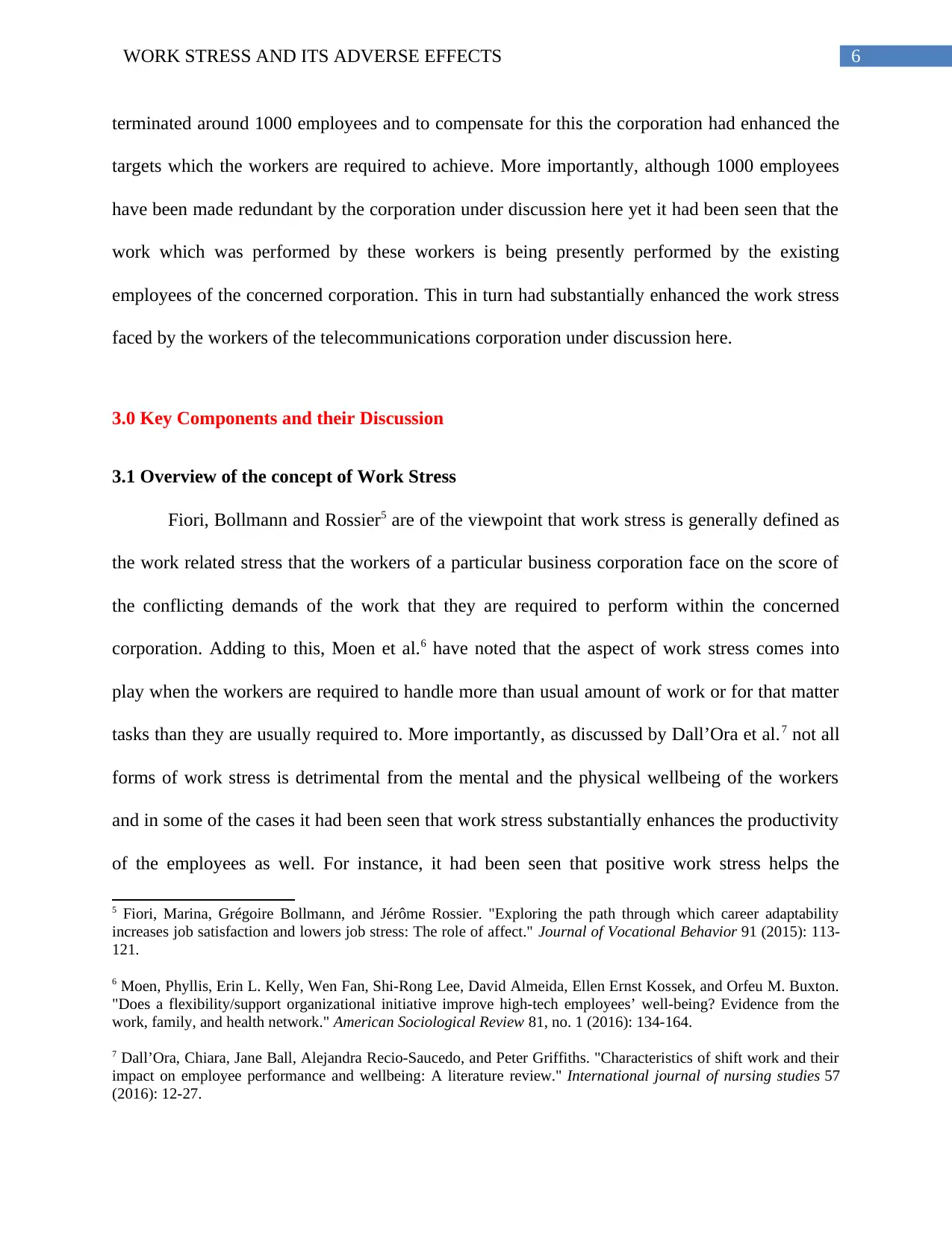
6WORK STRESS AND ITS ADVERSE EFFECTS
terminated around 1000 employees and to compensate for this the corporation had enhanced the
targets which the workers are required to achieve. More importantly, although 1000 employees
have been made redundant by the corporation under discussion here yet it had been seen that the
work which was performed by these workers is being presently performed by the existing
employees of the concerned corporation. This in turn had substantially enhanced the work stress
faced by the workers of the telecommunications corporation under discussion here.
3.0 Key Components and their Discussion
3.1 Overview of the concept of Work Stress
Fiori, Bollmann and Rossier5 are of the viewpoint that work stress is generally defined as
the work related stress that the workers of a particular business corporation face on the score of
the conflicting demands of the work that they are required to perform within the concerned
corporation. Adding to this, Moen et al.6 have noted that the aspect of work stress comes into
play when the workers are required to handle more than usual amount of work or for that matter
tasks than they are usually required to. More importantly, as discussed by Dall’Ora et al.7 not all
forms of work stress is detrimental from the mental and the physical wellbeing of the workers
and in some of the cases it had been seen that work stress substantially enhances the productivity
of the employees as well. For instance, it had been seen that positive work stress helps the
5 Fiori, Marina, Grégoire Bollmann, and Jérôme Rossier. "Exploring the path through which career adaptability
increases job satisfaction and lowers job stress: The role of affect." Journal of Vocational Behavior 91 (2015): 113-
121.
6 Moen, Phyllis, Erin L. Kelly, Wen Fan, Shi-Rong Lee, David Almeida, Ellen Ernst Kossek, and Orfeu M. Buxton.
"Does a flexibility/support organizational initiative improve high-tech employees’ well-being? Evidence from the
work, family, and health network." American Sociological Review 81, no. 1 (2016): 134-164.
7 Dall’Ora, Chiara, Jane Ball, Alejandra Recio-Saucedo, and Peter Griffiths. "Characteristics of shift work and their
impact on employee performance and wellbeing: A literature review." International journal of nursing studies 57
(2016): 12-27.
terminated around 1000 employees and to compensate for this the corporation had enhanced the
targets which the workers are required to achieve. More importantly, although 1000 employees
have been made redundant by the corporation under discussion here yet it had been seen that the
work which was performed by these workers is being presently performed by the existing
employees of the concerned corporation. This in turn had substantially enhanced the work stress
faced by the workers of the telecommunications corporation under discussion here.
3.0 Key Components and their Discussion
3.1 Overview of the concept of Work Stress
Fiori, Bollmann and Rossier5 are of the viewpoint that work stress is generally defined as
the work related stress that the workers of a particular business corporation face on the score of
the conflicting demands of the work that they are required to perform within the concerned
corporation. Adding to this, Moen et al.6 have noted that the aspect of work stress comes into
play when the workers are required to handle more than usual amount of work or for that matter
tasks than they are usually required to. More importantly, as discussed by Dall’Ora et al.7 not all
forms of work stress is detrimental from the mental and the physical wellbeing of the workers
and in some of the cases it had been seen that work stress substantially enhances the productivity
of the employees as well. For instance, it had been seen that positive work stress helps the
5 Fiori, Marina, Grégoire Bollmann, and Jérôme Rossier. "Exploring the path through which career adaptability
increases job satisfaction and lowers job stress: The role of affect." Journal of Vocational Behavior 91 (2015): 113-
121.
6 Moen, Phyllis, Erin L. Kelly, Wen Fan, Shi-Rong Lee, David Almeida, Ellen Ernst Kossek, and Orfeu M. Buxton.
"Does a flexibility/support organizational initiative improve high-tech employees’ well-being? Evidence from the
work, family, and health network." American Sociological Review 81, no. 1 (2016): 134-164.
7 Dall’Ora, Chiara, Jane Ball, Alejandra Recio-Saucedo, and Peter Griffiths. "Characteristics of shift work and their
impact on employee performance and wellbeing: A literature review." International journal of nursing studies 57
(2016): 12-27.
Paraphrase This Document
Need a fresh take? Get an instant paraphrase of this document with our AI Paraphraser
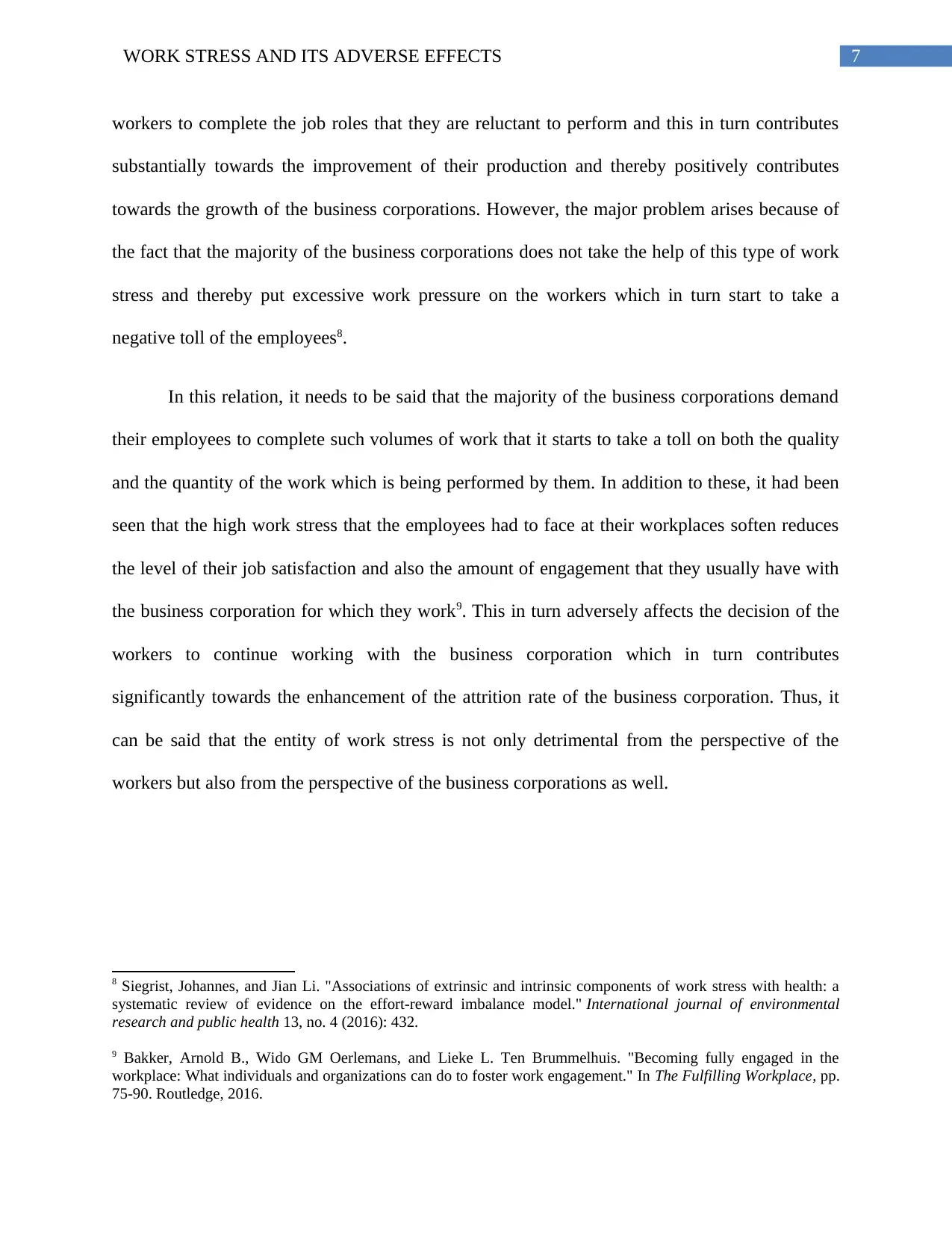
7WORK STRESS AND ITS ADVERSE EFFECTS
workers to complete the job roles that they are reluctant to perform and this in turn contributes
substantially towards the improvement of their production and thereby positively contributes
towards the growth of the business corporations. However, the major problem arises because of
the fact that the majority of the business corporations does not take the help of this type of work
stress and thereby put excessive work pressure on the workers which in turn start to take a
negative toll of the employees8.
In this relation, it needs to be said that the majority of the business corporations demand
their employees to complete such volumes of work that it starts to take a toll on both the quality
and the quantity of the work which is being performed by them. In addition to these, it had been
seen that the high work stress that the employees had to face at their workplaces soften reduces
the level of their job satisfaction and also the amount of engagement that they usually have with
the business corporation for which they work9. This in turn adversely affects the decision of the
workers to continue working with the business corporation which in turn contributes
significantly towards the enhancement of the attrition rate of the business corporation. Thus, it
can be said that the entity of work stress is not only detrimental from the perspective of the
workers but also from the perspective of the business corporations as well.
8 Siegrist, Johannes, and Jian Li. "Associations of extrinsic and intrinsic components of work stress with health: a
systematic review of evidence on the effort-reward imbalance model." International journal of environmental
research and public health 13, no. 4 (2016): 432.
9 Bakker, Arnold B., Wido GM Oerlemans, and Lieke L. Ten Brummelhuis. "Becoming fully engaged in the
workplace: What individuals and organizations can do to foster work engagement." In The Fulfilling Workplace, pp.
75-90. Routledge, 2016.
workers to complete the job roles that they are reluctant to perform and this in turn contributes
substantially towards the improvement of their production and thereby positively contributes
towards the growth of the business corporations. However, the major problem arises because of
the fact that the majority of the business corporations does not take the help of this type of work
stress and thereby put excessive work pressure on the workers which in turn start to take a
negative toll of the employees8.
In this relation, it needs to be said that the majority of the business corporations demand
their employees to complete such volumes of work that it starts to take a toll on both the quality
and the quantity of the work which is being performed by them. In addition to these, it had been
seen that the high work stress that the employees had to face at their workplaces soften reduces
the level of their job satisfaction and also the amount of engagement that they usually have with
the business corporation for which they work9. This in turn adversely affects the decision of the
workers to continue working with the business corporation which in turn contributes
significantly towards the enhancement of the attrition rate of the business corporation. Thus, it
can be said that the entity of work stress is not only detrimental from the perspective of the
workers but also from the perspective of the business corporations as well.
8 Siegrist, Johannes, and Jian Li. "Associations of extrinsic and intrinsic components of work stress with health: a
systematic review of evidence on the effort-reward imbalance model." International journal of environmental
research and public health 13, no. 4 (2016): 432.
9 Bakker, Arnold B., Wido GM Oerlemans, and Lieke L. Ten Brummelhuis. "Becoming fully engaged in the
workplace: What individuals and organizations can do to foster work engagement." In The Fulfilling Workplace, pp.
75-90. Routledge, 2016.
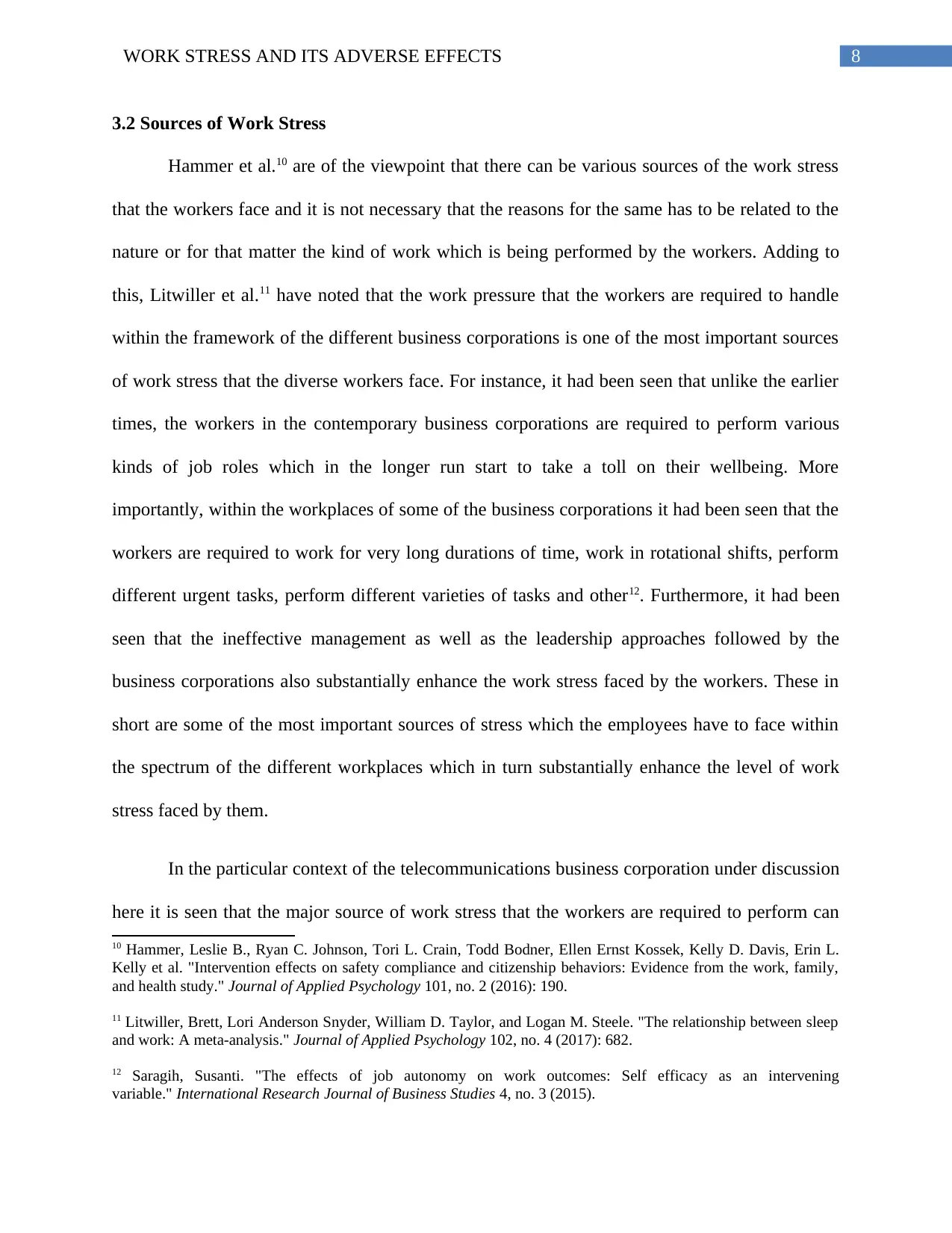
8WORK STRESS AND ITS ADVERSE EFFECTS
3.2 Sources of Work Stress
Hammer et al.10 are of the viewpoint that there can be various sources of the work stress
that the workers face and it is not necessary that the reasons for the same has to be related to the
nature or for that matter the kind of work which is being performed by the workers. Adding to
this, Litwiller et al.11 have noted that the work pressure that the workers are required to handle
within the framework of the different business corporations is one of the most important sources
of work stress that the diverse workers face. For instance, it had been seen that unlike the earlier
times, the workers in the contemporary business corporations are required to perform various
kinds of job roles which in the longer run start to take a toll on their wellbeing. More
importantly, within the workplaces of some of the business corporations it had been seen that the
workers are required to work for very long durations of time, work in rotational shifts, perform
different urgent tasks, perform different varieties of tasks and other12. Furthermore, it had been
seen that the ineffective management as well as the leadership approaches followed by the
business corporations also substantially enhance the work stress faced by the workers. These in
short are some of the most important sources of stress which the employees have to face within
the spectrum of the different workplaces which in turn substantially enhance the level of work
stress faced by them.
In the particular context of the telecommunications business corporation under discussion
here it is seen that the major source of work stress that the workers are required to perform can
10 Hammer, Leslie B., Ryan C. Johnson, Tori L. Crain, Todd Bodner, Ellen Ernst Kossek, Kelly D. Davis, Erin L.
Kelly et al. "Intervention effects on safety compliance and citizenship behaviors: Evidence from the work, family,
and health study." Journal of Applied Psychology 101, no. 2 (2016): 190.
11 Litwiller, Brett, Lori Anderson Snyder, William D. Taylor, and Logan M. Steele. "The relationship between sleep
and work: A meta-analysis." Journal of Applied Psychology 102, no. 4 (2017): 682.
12 Saragih, Susanti. "The effects of job autonomy on work outcomes: Self efficacy as an intervening
variable." International Research Journal of Business Studies 4, no. 3 (2015).
3.2 Sources of Work Stress
Hammer et al.10 are of the viewpoint that there can be various sources of the work stress
that the workers face and it is not necessary that the reasons for the same has to be related to the
nature or for that matter the kind of work which is being performed by the workers. Adding to
this, Litwiller et al.11 have noted that the work pressure that the workers are required to handle
within the framework of the different business corporations is one of the most important sources
of work stress that the diverse workers face. For instance, it had been seen that unlike the earlier
times, the workers in the contemporary business corporations are required to perform various
kinds of job roles which in the longer run start to take a toll on their wellbeing. More
importantly, within the workplaces of some of the business corporations it had been seen that the
workers are required to work for very long durations of time, work in rotational shifts, perform
different urgent tasks, perform different varieties of tasks and other12. Furthermore, it had been
seen that the ineffective management as well as the leadership approaches followed by the
business corporations also substantially enhance the work stress faced by the workers. These in
short are some of the most important sources of stress which the employees have to face within
the spectrum of the different workplaces which in turn substantially enhance the level of work
stress faced by them.
In the particular context of the telecommunications business corporation under discussion
here it is seen that the major source of work stress that the workers are required to perform can
10 Hammer, Leslie B., Ryan C. Johnson, Tori L. Crain, Todd Bodner, Ellen Ernst Kossek, Kelly D. Davis, Erin L.
Kelly et al. "Intervention effects on safety compliance and citizenship behaviors: Evidence from the work, family,
and health study." Journal of Applied Psychology 101, no. 2 (2016): 190.
11 Litwiller, Brett, Lori Anderson Snyder, William D. Taylor, and Logan M. Steele. "The relationship between sleep
and work: A meta-analysis." Journal of Applied Psychology 102, no. 4 (2017): 682.
12 Saragih, Susanti. "The effects of job autonomy on work outcomes: Self efficacy as an intervening
variable." International Research Journal of Business Studies 4, no. 3 (2015).
⊘ This is a preview!⊘
Do you want full access?
Subscribe today to unlock all pages.

Trusted by 1+ million students worldwide
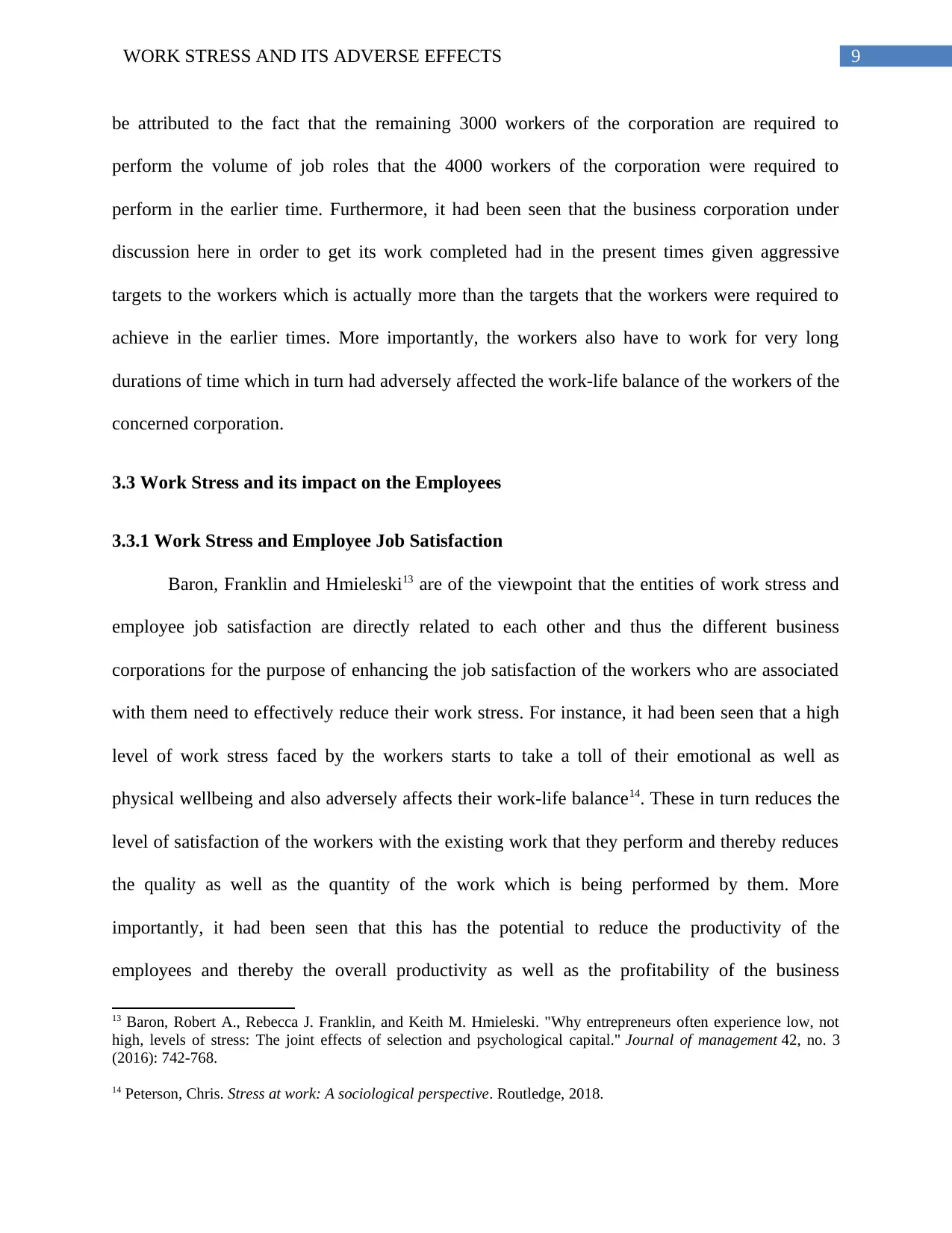
9WORK STRESS AND ITS ADVERSE EFFECTS
be attributed to the fact that the remaining 3000 workers of the corporation are required to
perform the volume of job roles that the 4000 workers of the corporation were required to
perform in the earlier time. Furthermore, it had been seen that the business corporation under
discussion here in order to get its work completed had in the present times given aggressive
targets to the workers which is actually more than the targets that the workers were required to
achieve in the earlier times. More importantly, the workers also have to work for very long
durations of time which in turn had adversely affected the work-life balance of the workers of the
concerned corporation.
3.3 Work Stress and its impact on the Employees
3.3.1 Work Stress and Employee Job Satisfaction
Baron, Franklin and Hmieleski13 are of the viewpoint that the entities of work stress and
employee job satisfaction are directly related to each other and thus the different business
corporations for the purpose of enhancing the job satisfaction of the workers who are associated
with them need to effectively reduce their work stress. For instance, it had been seen that a high
level of work stress faced by the workers starts to take a toll of their emotional as well as
physical wellbeing and also adversely affects their work-life balance14. These in turn reduces the
level of satisfaction of the workers with the existing work that they perform and thereby reduces
the quality as well as the quantity of the work which is being performed by them. More
importantly, it had been seen that this has the potential to reduce the productivity of the
employees and thereby the overall productivity as well as the profitability of the business
13 Baron, Robert A., Rebecca J. Franklin, and Keith M. Hmieleski. "Why entrepreneurs often experience low, not
high, levels of stress: The joint effects of selection and psychological capital." Journal of management 42, no. 3
(2016): 742-768.
14 Peterson, Chris. Stress at work: A sociological perspective. Routledge, 2018.
be attributed to the fact that the remaining 3000 workers of the corporation are required to
perform the volume of job roles that the 4000 workers of the corporation were required to
perform in the earlier time. Furthermore, it had been seen that the business corporation under
discussion here in order to get its work completed had in the present times given aggressive
targets to the workers which is actually more than the targets that the workers were required to
achieve in the earlier times. More importantly, the workers also have to work for very long
durations of time which in turn had adversely affected the work-life balance of the workers of the
concerned corporation.
3.3 Work Stress and its impact on the Employees
3.3.1 Work Stress and Employee Job Satisfaction
Baron, Franklin and Hmieleski13 are of the viewpoint that the entities of work stress and
employee job satisfaction are directly related to each other and thus the different business
corporations for the purpose of enhancing the job satisfaction of the workers who are associated
with them need to effectively reduce their work stress. For instance, it had been seen that a high
level of work stress faced by the workers starts to take a toll of their emotional as well as
physical wellbeing and also adversely affects their work-life balance14. These in turn reduces the
level of satisfaction of the workers with the existing work that they perform and thereby reduces
the quality as well as the quantity of the work which is being performed by them. More
importantly, it had been seen that this has the potential to reduce the productivity of the
employees and thereby the overall productivity as well as the profitability of the business
13 Baron, Robert A., Rebecca J. Franklin, and Keith M. Hmieleski. "Why entrepreneurs often experience low, not
high, levels of stress: The joint effects of selection and psychological capital." Journal of management 42, no. 3
(2016): 742-768.
14 Peterson, Chris. Stress at work: A sociological perspective. Routledge, 2018.
Paraphrase This Document
Need a fresh take? Get an instant paraphrase of this document with our AI Paraphraser
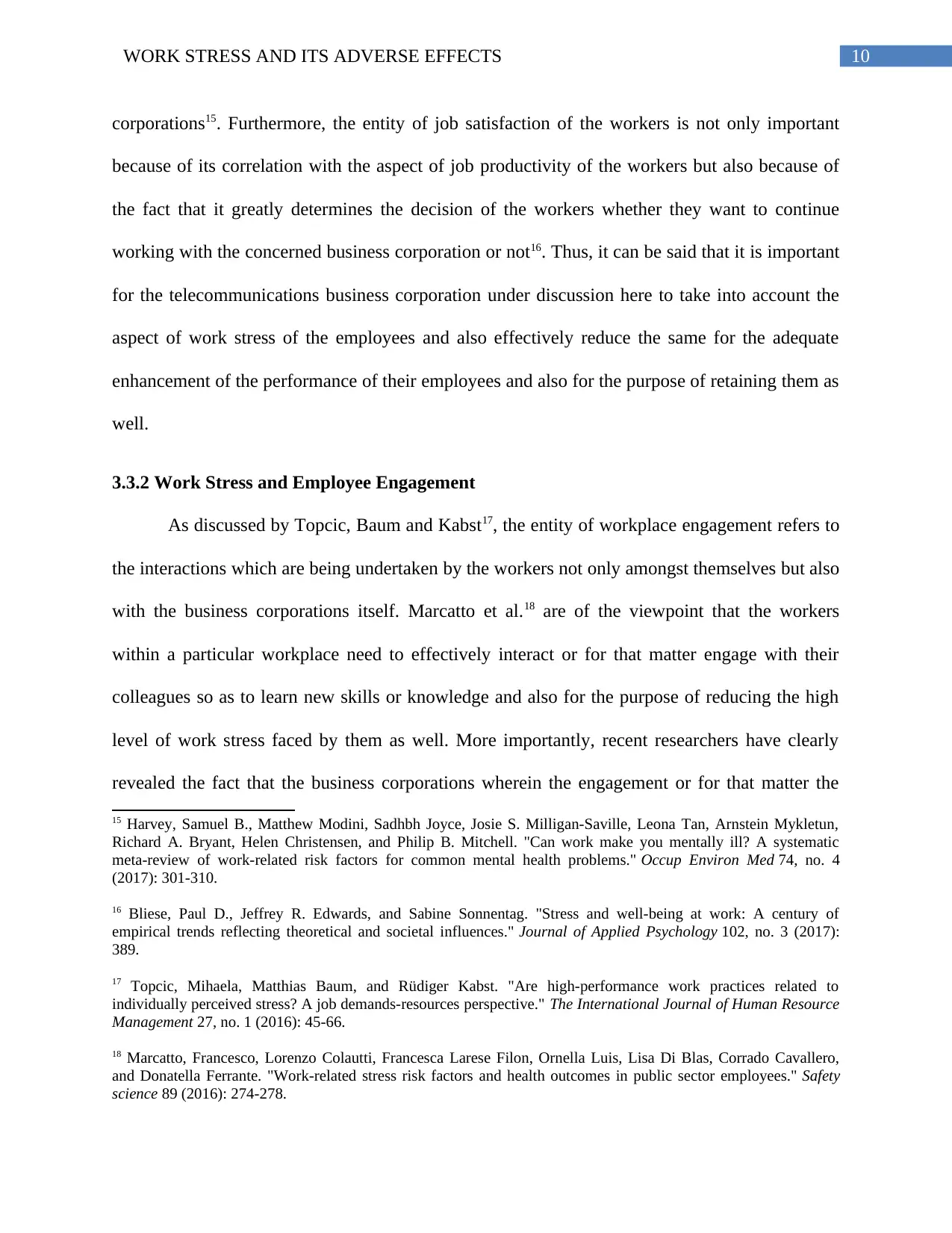
10WORK STRESS AND ITS ADVERSE EFFECTS
corporations15. Furthermore, the entity of job satisfaction of the workers is not only important
because of its correlation with the aspect of job productivity of the workers but also because of
the fact that it greatly determines the decision of the workers whether they want to continue
working with the concerned business corporation or not16. Thus, it can be said that it is important
for the telecommunications business corporation under discussion here to take into account the
aspect of work stress of the employees and also effectively reduce the same for the adequate
enhancement of the performance of their employees and also for the purpose of retaining them as
well.
3.3.2 Work Stress and Employee Engagement
As discussed by Topcic, Baum and Kabst17, the entity of workplace engagement refers to
the interactions which are being undertaken by the workers not only amongst themselves but also
with the business corporations itself. Marcatto et al.18 are of the viewpoint that the workers
within a particular workplace need to effectively interact or for that matter engage with their
colleagues so as to learn new skills or knowledge and also for the purpose of reducing the high
level of work stress faced by them as well. More importantly, recent researchers have clearly
revealed the fact that the business corporations wherein the engagement or for that matter the
15 Harvey, Samuel B., Matthew Modini, Sadhbh Joyce, Josie S. Milligan-Saville, Leona Tan, Arnstein Mykletun,
Richard A. Bryant, Helen Christensen, and Philip B. Mitchell. "Can work make you mentally ill? A systematic
meta-review of work-related risk factors for common mental health problems." Occup Environ Med 74, no. 4
(2017): 301-310.
16 Bliese, Paul D., Jeffrey R. Edwards, and Sabine Sonnentag. "Stress and well-being at work: A century of
empirical trends reflecting theoretical and societal influences." Journal of Applied Psychology 102, no. 3 (2017):
389.
17 Topcic, Mihaela, Matthias Baum, and Rüdiger Kabst. "Are high-performance work practices related to
individually perceived stress? A job demands-resources perspective." The International Journal of Human Resource
Management 27, no. 1 (2016): 45-66.
18 Marcatto, Francesco, Lorenzo Colautti, Francesca Larese Filon, Ornella Luis, Lisa Di Blas, Corrado Cavallero,
and Donatella Ferrante. "Work-related stress risk factors and health outcomes in public sector employees." Safety
science 89 (2016): 274-278.
corporations15. Furthermore, the entity of job satisfaction of the workers is not only important
because of its correlation with the aspect of job productivity of the workers but also because of
the fact that it greatly determines the decision of the workers whether they want to continue
working with the concerned business corporation or not16. Thus, it can be said that it is important
for the telecommunications business corporation under discussion here to take into account the
aspect of work stress of the employees and also effectively reduce the same for the adequate
enhancement of the performance of their employees and also for the purpose of retaining them as
well.
3.3.2 Work Stress and Employee Engagement
As discussed by Topcic, Baum and Kabst17, the entity of workplace engagement refers to
the interactions which are being undertaken by the workers not only amongst themselves but also
with the business corporations itself. Marcatto et al.18 are of the viewpoint that the workers
within a particular workplace need to effectively interact or for that matter engage with their
colleagues so as to learn new skills or knowledge and also for the purpose of reducing the high
level of work stress faced by them as well. More importantly, recent researchers have clearly
revealed the fact that the business corporations wherein the engagement or for that matter the
15 Harvey, Samuel B., Matthew Modini, Sadhbh Joyce, Josie S. Milligan-Saville, Leona Tan, Arnstein Mykletun,
Richard A. Bryant, Helen Christensen, and Philip B. Mitchell. "Can work make you mentally ill? A systematic
meta-review of work-related risk factors for common mental health problems." Occup Environ Med 74, no. 4
(2017): 301-310.
16 Bliese, Paul D., Jeffrey R. Edwards, and Sabine Sonnentag. "Stress and well-being at work: A century of
empirical trends reflecting theoretical and societal influences." Journal of Applied Psychology 102, no. 3 (2017):
389.
17 Topcic, Mihaela, Matthias Baum, and Rüdiger Kabst. "Are high-performance work practices related to
individually perceived stress? A job demands-resources perspective." The International Journal of Human Resource
Management 27, no. 1 (2016): 45-66.
18 Marcatto, Francesco, Lorenzo Colautti, Francesca Larese Filon, Ornella Luis, Lisa Di Blas, Corrado Cavallero,
and Donatella Ferrante. "Work-related stress risk factors and health outcomes in public sector employees." Safety
science 89 (2016): 274-278.
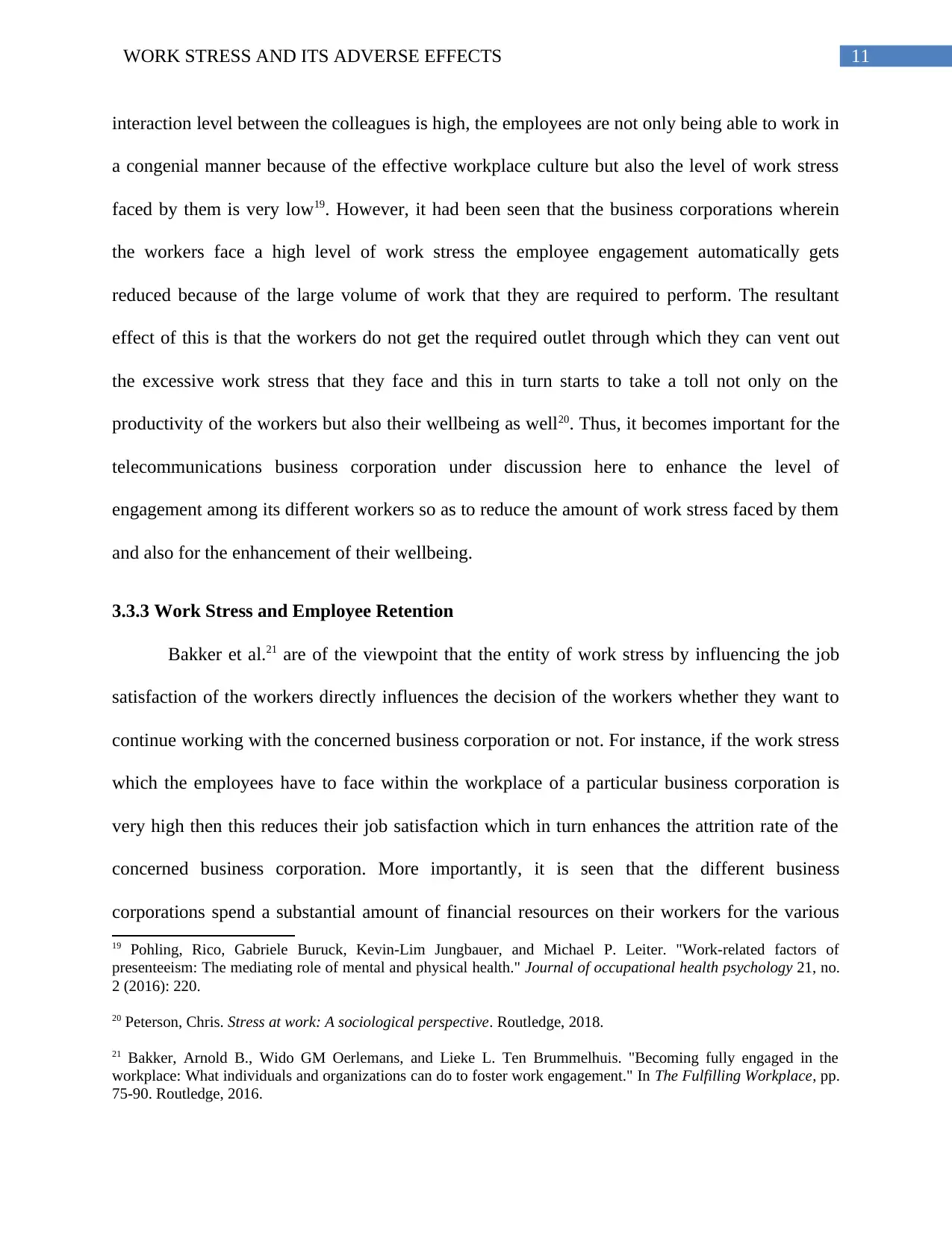
11WORK STRESS AND ITS ADVERSE EFFECTS
interaction level between the colleagues is high, the employees are not only being able to work in
a congenial manner because of the effective workplace culture but also the level of work stress
faced by them is very low19. However, it had been seen that the business corporations wherein
the workers face a high level of work stress the employee engagement automatically gets
reduced because of the large volume of work that they are required to perform. The resultant
effect of this is that the workers do not get the required outlet through which they can vent out
the excessive work stress that they face and this in turn starts to take a toll not only on the
productivity of the workers but also their wellbeing as well20. Thus, it becomes important for the
telecommunications business corporation under discussion here to enhance the level of
engagement among its different workers so as to reduce the amount of work stress faced by them
and also for the enhancement of their wellbeing.
3.3.3 Work Stress and Employee Retention
Bakker et al.21 are of the viewpoint that the entity of work stress by influencing the job
satisfaction of the workers directly influences the decision of the workers whether they want to
continue working with the concerned business corporation or not. For instance, if the work stress
which the employees have to face within the workplace of a particular business corporation is
very high then this reduces their job satisfaction which in turn enhances the attrition rate of the
concerned business corporation. More importantly, it is seen that the different business
corporations spend a substantial amount of financial resources on their workers for the various
19 Pohling, Rico, Gabriele Buruck, Kevin-Lim Jungbauer, and Michael P. Leiter. "Work-related factors of
presenteeism: The mediating role of mental and physical health." Journal of occupational health psychology 21, no.
2 (2016): 220.
20 Peterson, Chris. Stress at work: A sociological perspective. Routledge, 2018.
21 Bakker, Arnold B., Wido GM Oerlemans, and Lieke L. Ten Brummelhuis. "Becoming fully engaged in the
workplace: What individuals and organizations can do to foster work engagement." In The Fulfilling Workplace, pp.
75-90. Routledge, 2016.
interaction level between the colleagues is high, the employees are not only being able to work in
a congenial manner because of the effective workplace culture but also the level of work stress
faced by them is very low19. However, it had been seen that the business corporations wherein
the workers face a high level of work stress the employee engagement automatically gets
reduced because of the large volume of work that they are required to perform. The resultant
effect of this is that the workers do not get the required outlet through which they can vent out
the excessive work stress that they face and this in turn starts to take a toll not only on the
productivity of the workers but also their wellbeing as well20. Thus, it becomes important for the
telecommunications business corporation under discussion here to enhance the level of
engagement among its different workers so as to reduce the amount of work stress faced by them
and also for the enhancement of their wellbeing.
3.3.3 Work Stress and Employee Retention
Bakker et al.21 are of the viewpoint that the entity of work stress by influencing the job
satisfaction of the workers directly influences the decision of the workers whether they want to
continue working with the concerned business corporation or not. For instance, if the work stress
which the employees have to face within the workplace of a particular business corporation is
very high then this reduces their job satisfaction which in turn enhances the attrition rate of the
concerned business corporation. More importantly, it is seen that the different business
corporations spend a substantial amount of financial resources on their workers for the various
19 Pohling, Rico, Gabriele Buruck, Kevin-Lim Jungbauer, and Michael P. Leiter. "Work-related factors of
presenteeism: The mediating role of mental and physical health." Journal of occupational health psychology 21, no.
2 (2016): 220.
20 Peterson, Chris. Stress at work: A sociological perspective. Routledge, 2018.
21 Bakker, Arnold B., Wido GM Oerlemans, and Lieke L. Ten Brummelhuis. "Becoming fully engaged in the
workplace: What individuals and organizations can do to foster work engagement." In The Fulfilling Workplace, pp.
75-90. Routledge, 2016.
⊘ This is a preview!⊘
Do you want full access?
Subscribe today to unlock all pages.

Trusted by 1+ million students worldwide
1 out of 21
Related Documents
Your All-in-One AI-Powered Toolkit for Academic Success.
+13062052269
info@desklib.com
Available 24*7 on WhatsApp / Email
![[object Object]](/_next/static/media/star-bottom.7253800d.svg)
Unlock your academic potential
Copyright © 2020–2025 A2Z Services. All Rights Reserved. Developed and managed by ZUCOL.





